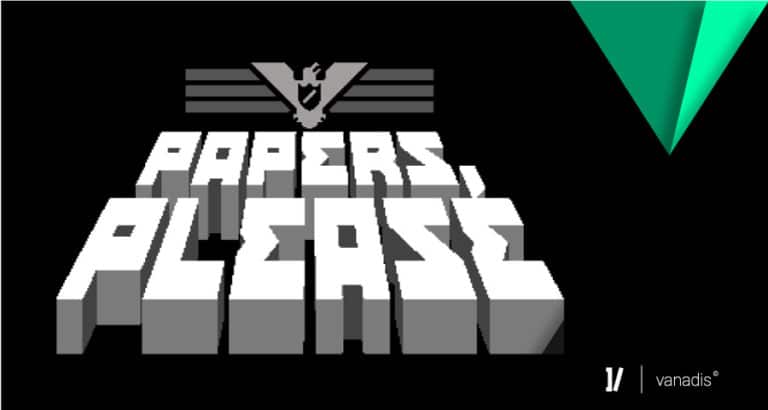Analizando Papers Please, o como ser un buen inspector de inmigración

Hoy os vengo a analizar algunas de las mecánicas de un juego independiente el cual recomiendo al menos probarlo a todo el mundo porque creo merece la pena por su originalidad, pero si te dedicas a la gamificación entonces creo que es imprescindible.
 La estética retro usando pixel art para un entorno de guerra fría es perfecta.
La estética retro usando pixel art para un entorno de guerra fría es perfecta.
El juego en cuestión es Papers, Please creado por Lucas Pope desarrollador independiente. La idea es sencilla Papers, Please nos sitúa como un inspector de inmigración en un puesto fronterizo entre dos estados ficticios Arstozka y Kolechia. El jugador tendrá que ir inspeccionando los documentos de los inmigrantes comprobando que cumplen la normativa de acceso al país, normativa que se actualiza y endurece cada día. Cada vez que se produce una discrepancia el inspector puede interrogar a los inmigrantes y solicitar información adicional como revisar las huellas digitales o hacer un escáner de cuerpo completo. Llegará un momento en el que se podrá arrestar a los que quieren entrar o aceptar sobornos y otra serie de acontecimientos.
El factor motivador principal para el personaje es lograr el máximo dinero cada día para cuidar de su familia que tendrá que alimentar, dar sus medicinas, etc. Lo cual es muy complicado dada la dificultad del trabajo a desempeñar donde el salario es miserable (se paga por número de personas atendidas más “otros extras”) y además te penalizan por cada usuario al que no hayas detectado alguna incongruencia, falsificación o error en su documentación.
Puestos ya un poco en contexto me gustaría analizar algunas mecánicas y cómo logran que el jugador esté completamente inmerso en el juego.
- Dificultad ascendente y presión. Desde el principio te encuentras con el problema de conocer toda la documentación de cada país, sus sellos, tipos de pasaportes, tarjetas de residencia, etc. Y si bien los primeros días (dentro del juego) la dificultad es bastante llevadera, en muy poco tiempo te das cuenta de lo difícil que es ser productivo y la necesidad de ser muy rápido al gestionar a los usuarios que pasan por tu puesto.
- Factor motivador muy fuerte. No hay motivador más fuerte que lograr que el personaje que controlas pueda mantener a su familia, pero irán apareciendo nuevas historias paralelas que aumentarán tu motivación.
- Impredictibilidad. A pesar de tener que hacer un trabajo rutinario hay tal variedad de casos y sorpresas que te hacen permanecer atento constantemente.
 Nunca se sabe lo que puede esconder alguno de los usuarios.
Nunca se sabe lo que puede esconder alguno de los usuarios.
- Capacidad de elección. Durante la historia podrás ir decidiendo que hacer, lo primero con algo tan sencillo como dejar o no pasar a una persona, coger o no un objeto y entregárselo a otro, aceptar sobornos, compincharte con la policía para sacar más dinero deteniendo a más personas, etc.
- Sistema de refuerzos y castigos asociados a nuestra conducta. Cada inmigrante que gestionamos correctamente nos proporciona el dinero para mantener a nuestra familia y cada gestión errónea nos generará una multa.
- Feedback inmediato sobre tu conducta. En el momento que dejamos pasar a una persona que no deberíamos a “nuestra amada nación” Arstozka, el error te lo notifican mediante una nota y proceden a imponerte la sanción.
- Posibilidad de comprar shortcuts. En cierto momento aparecen disponibles mejoras (atajos en el teclado para gestionar el menú) que te permiten gestionar el papeleo de forma más sencilla y logra que pese al coste que tienen estas mejoras quieras conseguirlas.
- Guionizado e historias paralelas. Mientras que estás revisando el papeleo te encontrarás con una infinidad de historias que influirán en tu toma de decisiones.
- Finales diferentes. Tienes dependiendo de tus elecciones diferentes finales que te valen para fomentar la rejugabilidad y para que tus acciones queden enmarcadas en un fin mayor, Epic Meaning.
 La cantidad de datos, fichas, pasaportes, sellos, etc., es abrumadora, pero te los acabas aprendiendo.
La cantidad de datos, fichas, pasaportes, sellos, etc., es abrumadora, pero te los acabas aprendiendo.
Todas estas mecánicas logran justo el objetivo buscado por el diseñador que es que te mantengas concentrado, enfocado en la materia y que en definitiva te entretenga y divierta.
También logra a la par un efecto colateral que es muy de utilidad para los gamificadores y especialmente si lo centramos al área de formación. Ese efecto es el aprendizaje de la cantidad de normativa y datos asociados a tu trabajo como inspector. En cierto momento te acabas dando cuenta que ya no consultas los manuales, que vienen incluidos dentro del juego para poder consultarlos en tiempo real, perdiendo eso sí tu valioso tiempo en la partida.
Esto fomenta que estudies fuera del juego, te ves consultando los manuales de los diferentes protocolos en internet antes de ponerte a jugar, para mejorar tu rendimiento.
Parece claro que el área de formación de cualquier empresa estaría encantada de lograr esto, que sus trabajadores estudien fuera del trabajo y que ante actividades monótonas se centrasen y prestarán el máximo de atención por el mayor tiempo posible.
Hemos visto que analizando las mecánicas usadas en este juego podemos sacar algunas herramientas que podemos utilizar a la hora de mejorar la experiencia del trabajador y fomentar esas conductas que deseamos. Ya es competencia de nosotros los gamificadores adaptarlo a las necesidades del proyecto.
——–
Analyzing Papers Please, or how to become a good immigration inspector.
Today I came to analyze some of the mechanics of an independent game that I recommend everyone to at least try it because I think it is worthy due its originality, but if you dedicate yourself to gamification then I think it is a must.
 Retro aesthetics using pixel art for a cold war environment is perfect.
Retro aesthetics using pixel art for a cold war environment is perfect.
The game is Papers, Please created by Lucas Pope an independent developer. The idea quite is simple in Papers, Please you become an immigration inspector at a border post between two fictional states, Arstozka and Kolechia. The player will have to inspect the immigrants’ documents proving that they comply with the regulations on entering the country, a regulation that is updated and hardens every day. Every time a discrepancy appears, the inspector can interrogate the immigrants and request additional information such as fingerprinting or a full-body scanner. There will come a time when you can arrest those who want to enter or accept bribes and other kind of events.
The main objective for the character is to obtain the largest amount of money every day to take care of his family, in order to feed them, give them their medicines, etc. This is something very complicated given the difficulty of the job. The salary is miserable (paid by number of people attended plus «other extras») and with a penalty for each user that you haven’t detected any inconsistency, falsification or error in their documentation.
Now that we know what is the game about I would like to analyze some mechanics and how they manage to make the player completely immersed into the game.
- Increasingly difficulty level and pressure. From the very beginning, you see that you will have a problem knowing all the documentation of each country, their stamps, types of passports, residence cards, etc. And while the first few days (within the game) the difficulty is quite bearable, in a very short time you realize how difficult it is to be productive and the need of being very fast when managing users who pass through your post.
- A very strong motivating factor. There is no stronger motivator than help your character to support his family, and little by little will appear new parallel stories that will increase your motivation.
- Unpredictability. Despite having to do a routine job there are such a variety of cases and surprises that you will stay alert constantly.
 You never know what can hide some of the users.
You never know what can hide some of the users.
- Capacity of choice. During the story you can decide what to do, at the very beginning with something as simple as to let or not to pass a person, to take or not an object and give it to another one, to accept bribes, to come to terms with the police to get more money stopping more people, etc.
- A system of reinforcements and punishments associated to our behavior. Each immigrant that we manage correctly provides us some money to support our family and each wrong management will generate a fine.
- Immediate feedback on your behavior. At the same moment we let a person to pass to «our beloved nation» Arstozka that we shouldn’t have done it, the mistake is notified us by a note and the state proceed to impose us a sanction.
- Opportunity to buy shortcuts. At a certain point, some improvements (keyboard shortcuts to manage our office’s desk) are available to allow us to manage paperwork easilier and that’s why despite the cost of these improvements that you want to get them.
- Script and parallel stories. While you are reviewing the different documents you will find a myriad of stories that will influence your decision making.
- Different endings. Depending on your choices, you will have different endings that apart from the foment of the replayability they will set your actions framed in a greater ending, an Epic Meaning.
 The amount of data, tokens, passports, stamps, etc., is overwhelming, but you will learn it.
The amount of data, tokens, passports, stamps, etc., is overwhelming, but you will learn it.
The amount of data, tokens, passports, stamps, etc., is overwhelming, but you will learn it.
All these mechanics find the main objective of the designer that is to make you stay focused in the game and having fun.
It also achieves at the same time a side effect that is very useful for gamifiers and especially if we focus it to the training area. That effect is to learn the amount of regulations and data associated with your work as an inspector. At some point you realize that you are not longer consulting the manuals, which come included in the game to be able to consult them in real time losing of course your valuable time in the game.
This encourages you to study outside the game, you see yourself consulting the manuals of different protocols on the internet before you play, to improve your performance.
It seems clear that the training area of any company would be happy to achieve this, that their workers will study outside of work and that during monotonous activities they will stay focus and paying the maximum attention to it for as long as possible.
We have seen that analyzing the mechanics used in this game help us to draw some tools that we can use to improve the experience of the worker and encourage those behaviors that we want. It is already up to us the gamifiers to adapt that mechanics to the needs of the project.



